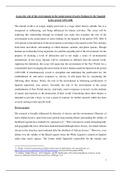Assess the role of the environment in the enslavement of native Indians by the Spanish
in the period 1492-1600.
The natural world is no longer simply perceived as a stage where history unfolds, but it is
recognised as influencing, and being influenced by human activities. This essay will be
exploring this relationship through an in-depth case study that considers the role of the
environment in the enslavement of native Indians by the Spanish in the period 1492-1600. It
will operate on the definition of the environment as referring to the natural world. This includes
both biotic and abiotic surroundings in which humans, animals, and plants operate. Though
humans are technically living organisms too and thus arguably part of the environment, for the
purpose of retaining a level of distinction and to not imply a sense of environmental
determinism, in this essay, humans will be considered as different from the natural world.
Applying this definition, this essay will argue that the environment of the New World was a
considerable factor in shaping the enslavement of native Indians under the Spanish in the period
1492-1600. It simultaneously served to strengthen and undermine the justification for, the
establishment of, and native responses to, slavery. It will argue this by considering the
following three themes. Firstly, the role of the environment in bolstering justifications of
Spanish superiority over natives. Secondly, the role of the environment in the actual
establishment of New World slavery. And lastly, native responses to slavery via the medium
of nature and reactions to the destruction of their world. Considering these three themes is
intended to provide a basis, or even a point of contrast, for further research which has been
severely lacking in this specific field.
Historiography
My research is broadly influenced by histories of slavery and the environment. Histories of
native Indian slavery, apart from more general long-running debate surrounding the validity of
the Black Legend, have tended to be ‘glossed over’.1 This is because its extent chronologically
and geographically have often been underestimated although native slavery ‘pre-dated African
slavery in the Americas and continued after the abolition of African slavery’.2 However, even
debate over the validity of the Black Legend versus the White Legend is centred on Spanish
rather than native agency. The former holds Spaniards responsible for the murder and
1
L. Fisher, Colonial enslavement of Native Americans included those who surrendered, too
https://news.brown.edu/articles/2017/02/enslavement [accessed 26 November 2018]
2
A. Gallay, ‘Indian Slavery’, in R. Paquette., and M. Smith (eds.), The Oxford handbook of slavery in the
Americas (Oxford: Oxford University Press, 2010) pp. 314.
1
, enslavement of Indians, whereas the latter states they had a ‘positive Christian influence,
eliminating human sacrifice and cannibalism whilst offering material benefits.’3 As well as
often excluding native experiences, this dichotomy prevents complexity and nuance as
although both legends are valid to an extent, neither reveal the whole truth. To an extent this
essay has attempted to counter this historiographical trend by not only seeking to assess rather
than to take sides, but also by attempting to recover native responses to their land and
themselves being enslaved.
Similarly, historiography has tended to ignore the environment too, which is perhaps
emblematic of attitudes towards nature today. Only in the last forty years has there been a
resurgence in the recognition that humans are shaped by and shape the natural world. This has
resulted in the notion of the Anthropocene- a proposed geological epoch during which human
activity has been the dominant influence on climate and the environment.4 More specifically,
the greatest advance in the field of environmental studies and the discovery of the New World
was by Crosby, in his book ‘The Columbian Exchange: biological and cultural consequences
of 1492’. This essay will attempt to apply an environmental approach inspired by Crosby, but
unlike Crosby, widened beyond only considering the role of biological organisms as the
definition of environment is much more extensive than this. This essay will consider disease
but also other environmental factors like the prevalence of natural resources, the importance of
physical claims over land and the nature of the landscape. Whilst this is reflective of increasing
inter-disciplinary cooperation, there is currently no definitive scholarship on the role of the
environment in shaping Spanish-Indian relations besides vague comments on how the natural
world has shaped perceptions of race. However, assessing the role of the environment may not
only be valuable when studying native Indian slavery, but could prove valuable in better
contextualising and understanding the subsequent ‘enslavement of Africans, the evolution of
racial ideologies, and the meaning of exploitation of humans by humans.’5 Therefore, this essay
will very much provide a starting basis, or even a point of juxtaposition, for much needed
further research into the role of the environment in the justification for, the establishment of,
and native responses to slavery.
3
C. Gibson., Spain in America (London: Harper & Row, 1966) pp. 136.
4
P. Crutzen, ‘Anthropocene man’, in Nature, Vol.467, 7317(2010) https://www.nature.com/articles/467S10a
[accessed 25 November 2018]
5
A. Gallay, ‘Indian Slavery’, pp. 318.
2




